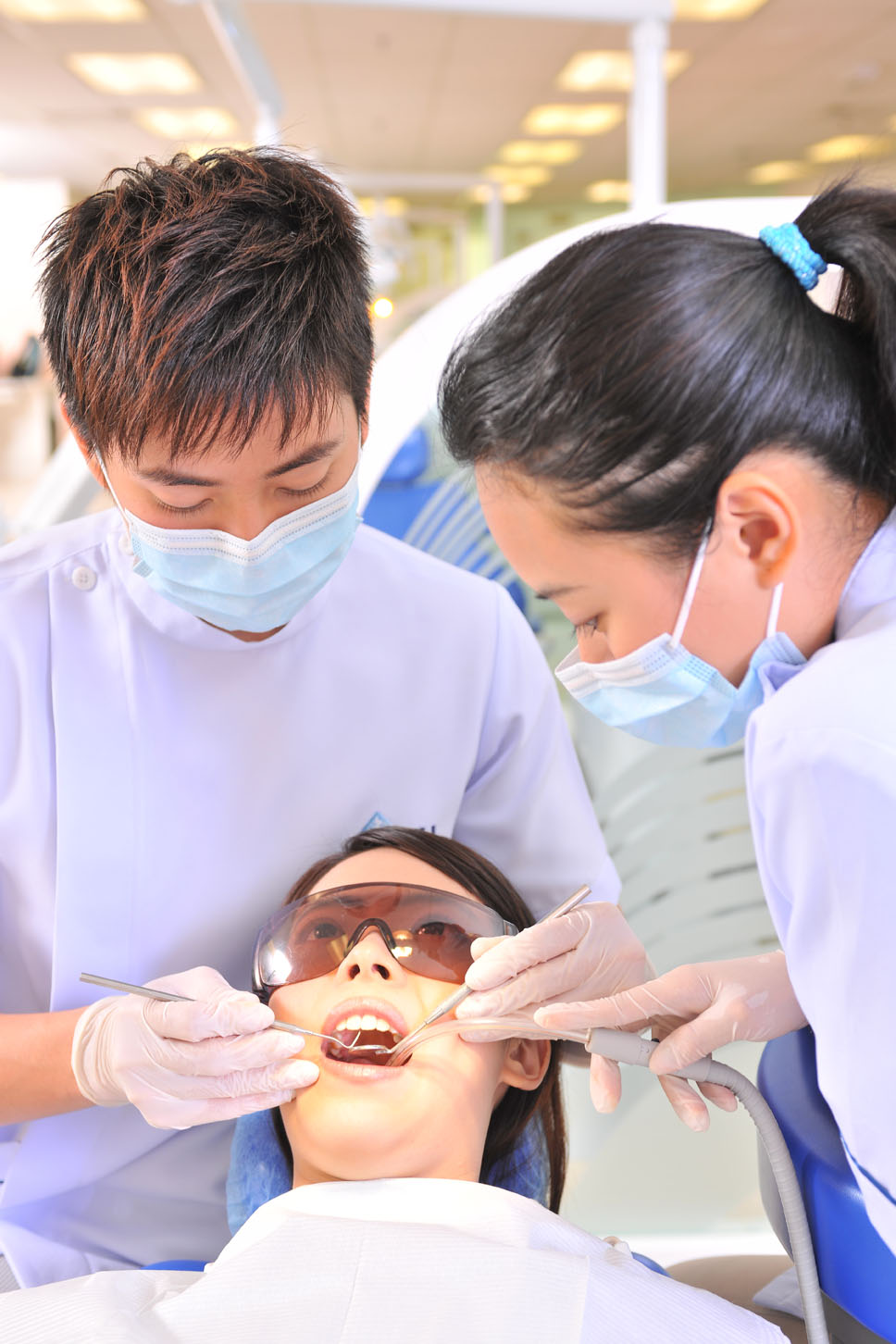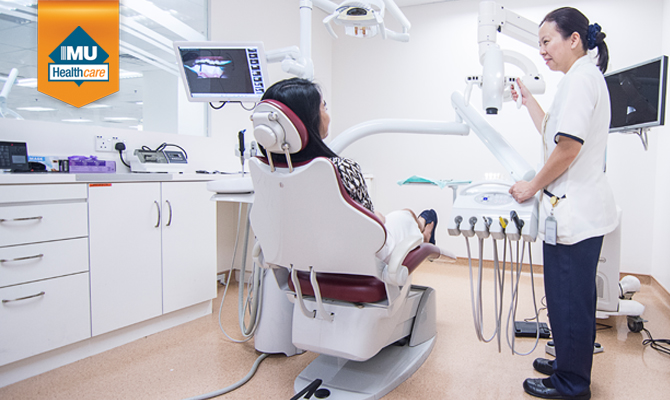A smile may be one of the most beautiful things a person can have, but not everyone is blessed with perfect teeth. Overcrowding, an over bite, or poor alignment of teeth can make a person hesitant to put on a big smile. In some cases the teeth may be straight, but the upper and lower jaws may not meet properly, possibly a result of injury, early or late tooth loss, or thumb-sucking. How do I Know if I Need Orthodontics? Only your dentist or orthodontist can determine whether you can benefit from orthodontics. Based on diagnostic tools that include a full medical and dental health history, a clinical exam, plaster models of your teeth, and special X-rays and photographs, an orthodontist or dentist can decide whether orthodontics are recommended, and develop a treatment plan that’s right for you. For the above issues, an orthodontist may recommend braces or other orthodontic treatment to bring out that big smile. Braces are a common sight, and now, more and more adults can be seen with them. Children, however, should not be fitted for braces until all their baby milk teeth have fallen out. Types of Braces Technology and innovation have ensured that we have so many more choices now than the metal ones from decades past that may make us feel self-conscious. That said, the type that still pops up in our head when someone mention braces are the ones consisting of metal brackets and wires. While these are the most noticeable types, modern brackets are smaller and less noticeable than the notorious “metal-mouth” braces that many older adults remember. Plus, new heat-activated archwires use your body heat to help teeth move more quickly and less painfully than in the past.  Ceramic braces are constructed just like metal braces, with wires and brackets, except that they have tooth-coloured or clear brackets that blend in to teeth. Some add tooth-coloured wires to make them even less noticeable to reduce feeling self-conscious about wearing dental braces. Aside from being slightly more expensive than traditional metal braces, the primary concern for most people when considering this option is that the brackets may stain easily if they are not vigilant in ensuring proper care and maintenance. A less commonly known type is the Lingual braces. These are much like metal braces in construction (with wires and brackets) except that they are placed behind the teeth (by the tongue and palate); making them invisible from the outside to a casual observer. Although it offer a great cosmetic alternative for those who want their teeth straightened, lingual braces have special requirements. Because they’re custom made, they cost a bit more and treatment tends to be more involved. One of the most talked-about types of braces are the Invisalign braces. Invisalign is short for Invisible Aligners, and that is exactly what it is. They are custom-made, clear plastic braces that resemble a mouth guard. These aligners are moulded to the shape of your teeth, so basically you just need to slip them over your teeth. In addition to being almost invisible; the aligners can be removed when eating and for cleaning. You can take them off to brush your teeth at night before putting them on again. As with all treatment option, however, there are disadvantages. Firstly, these braces are suitable only for adults and teens, not children and may also not be suitable for more severe cases. Secondly, because they are custom-made for each individual, in the event a wearer needs to replace them (through loss or damage) the replacement can be very costly. You and Your Braces There are many considerations to bear in mind when you have been advised to or are already wearing braces. Most of these revolve around care and maintenance such as visiting an orthodontist at least every six to eight weeks primarily to ensure the braces fit properly and also, if they need adjusting to have them adjusted properly by a qualified professional. This ensures the best possible outcome.
Ceramic braces are constructed just like metal braces, with wires and brackets, except that they have tooth-coloured or clear brackets that blend in to teeth. Some add tooth-coloured wires to make them even less noticeable to reduce feeling self-conscious about wearing dental braces. Aside from being slightly more expensive than traditional metal braces, the primary concern for most people when considering this option is that the brackets may stain easily if they are not vigilant in ensuring proper care and maintenance. A less commonly known type is the Lingual braces. These are much like metal braces in construction (with wires and brackets) except that they are placed behind the teeth (by the tongue and palate); making them invisible from the outside to a casual observer. Although it offer a great cosmetic alternative for those who want their teeth straightened, lingual braces have special requirements. Because they’re custom made, they cost a bit more and treatment tends to be more involved. One of the most talked-about types of braces are the Invisalign braces. Invisalign is short for Invisible Aligners, and that is exactly what it is. They are custom-made, clear plastic braces that resemble a mouth guard. These aligners are moulded to the shape of your teeth, so basically you just need to slip them over your teeth. In addition to being almost invisible; the aligners can be removed when eating and for cleaning. You can take them off to brush your teeth at night before putting them on again. As with all treatment option, however, there are disadvantages. Firstly, these braces are suitable only for adults and teens, not children and may also not be suitable for more severe cases. Secondly, because they are custom-made for each individual, in the event a wearer needs to replace them (through loss or damage) the replacement can be very costly. You and Your Braces There are many considerations to bear in mind when you have been advised to or are already wearing braces. Most of these revolve around care and maintenance such as visiting an orthodontist at least every six to eight weeks primarily to ensure the braces fit properly and also, if they need adjusting to have them adjusted properly by a qualified professional. This ensures the best possible outcome.  People fitted with braces for the first time can experience discomfort or even pain. Your mouth is very sensitive to change and so it may take a few days to get used to talking, eating or playing certain musical instruments with braces on. There are also things you should not do when wearing braces, such as chewing your pen or pencil or biting your nails as this may cause structural damage to your braces. Eating with braces on, especially if you are a first-time wearer, can pose a few challenges, and not simply because of the adjustment of having a foreign apparatus in your mouth. It is recommended to stick to soft foods like soups and bananas for the first few days and – more importantly – to avoid sticky, chewy and sugary foods that sticks to braces and might be difficult to remove like chewing gum and corn-on-the-cob. Which brings us to the subject of cleaning your braces. Wearing braces requires being extra diligent when cleaning teeth and braces. Improper and insufficient cleaning can lead to tooth decay, inflamed gums and tooth decalcification (when you lose the calcium from the surface of your teeth). Get proper advice on oral cleaning and care from your orthodontist. Next Stop: Orthodontist There are a lot of treatment options these days, from retainers to clear aligners to invisible, metal, ceramic and micro braces. They each have their uses. The length of time to properly move your teeth to the desired alignment would depend on the scope and severity of the situation which differs for each individual as well as the type braces used. Based on variables like your age, possible jaw imbalances, differences in the size of your teeth, and more, it is best to talk to an orthodontist on what to use, when to use it, and what will work for you to make the best decision – for your best smile.
People fitted with braces for the first time can experience discomfort or even pain. Your mouth is very sensitive to change and so it may take a few days to get used to talking, eating or playing certain musical instruments with braces on. There are also things you should not do when wearing braces, such as chewing your pen or pencil or biting your nails as this may cause structural damage to your braces. Eating with braces on, especially if you are a first-time wearer, can pose a few challenges, and not simply because of the adjustment of having a foreign apparatus in your mouth. It is recommended to stick to soft foods like soups and bananas for the first few days and – more importantly – to avoid sticky, chewy and sugary foods that sticks to braces and might be difficult to remove like chewing gum and corn-on-the-cob. Which brings us to the subject of cleaning your braces. Wearing braces requires being extra diligent when cleaning teeth and braces. Improper and insufficient cleaning can lead to tooth decay, inflamed gums and tooth decalcification (when you lose the calcium from the surface of your teeth). Get proper advice on oral cleaning and care from your orthodontist. Next Stop: Orthodontist There are a lot of treatment options these days, from retainers to clear aligners to invisible, metal, ceramic and micro braces. They each have their uses. The length of time to properly move your teeth to the desired alignment would depend on the scope and severity of the situation which differs for each individual as well as the type braces used. Based on variables like your age, possible jaw imbalances, differences in the size of your teeth, and more, it is best to talk to an orthodontist on what to use, when to use it, and what will work for you to make the best decision – for your best smile.
References: http://www.mayoclinic.org/dental-braces/expert-answers/faq-20058192 http://www.colgate.com/en/us/oc/oral-health/cosmetic-dentistry/early-orthodontics/article/how-much-do-braces-cost-for-kids-1014 http://www.lingualbraces.org/ http://www.mouthhealthy.org/en/az-topics/b/braces https://www.mylifemysmile.org/ http://www.nhs.uk/Livewell/dentalhealth/Pages/braces.aspx http://www.bos.org.uk/Public-Patients/Orthodontics-for-Children-Teens https://expertbeacon.com/getting-braces-straighten-your-child-s-teeth-requires-early-preparation#.V10ZHtJ95dg
This article is brought to you by IMU Healthcare.









